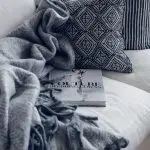Hey there, ready to upgrade your home with fabrics that can stand the test of time? Choosing the most durable fabric for your furniture is crucial for creating a cozy yet long-lasting environment. With so many options out there, it's important to understand which fabrics will hold up to the wear and tear of daily life.
Whether it's for your couch, chairs, or curtains, you want fabric that can handle whatever your household throws at it. Let's dive into the world of durable fabrics and find the perfect match for your home.
Key Takeaways
- Durability is important for withstanding everyday wear and tear.
- Factors affecting fabric durability include wear and tear, maintenance requirements, abrasion resistance, pilling, and fading due to light exposure.
- Maintenance requirements for durable fabrics include regular cleaning, rotating and fluffing cushions, following manufacturer's instructions, and immediate attention to spills or stains.
- Top durable fabric options include leather, synthetic microfiber, and heavy-duty cotton and wool blends, which can withstand the demands of everyday use.
Importance of Durable Fabrics
When choosing fabrics for your home, durability is essential for withstanding everyday wear and tear. The importance of durable fabrics can't be overstated, as they contribute to the longevity of your furniture.
Durability ratings and testing are crucial factors to consider when selecting fabric options. Fabrics with high durability ratings have undergone extensive testing to ensure they can withstand the rigors of daily use.
Considering fabric factors such as maintenance and wear and tear is imperative when making upholstery care decisions. Your furniture selection can greatly benefit from investing in durable fabrics, as they offer long-term investment benefits. Choosing the right fabric can save you money in the long run by reducing the need for frequent replacements or repairs.
Therefore, understanding the various fabric choices and durability testing methods is essential for making informed decisions about which fabrics will best suit your needs.
Factors Affecting Fabric Durability
When it comes to fabric durability, there are a few key factors to consider.
Wear and tear is a major factor – fabrics that can withstand frequent use and still look good are essential for long-lasting furniture.
Additionally, maintenance requirements play a significant role in the overall durability of a fabric, so it's important to choose a fabric that aligns with your lifestyle and maintenance preferences.
Wear and Tear
To assess the durability of fabric, you should consider factors such as abrasion, pilling, and fading.
Abrasion resistance testing measures the fabric's ability to withstand wear from rubbing and friction. Fabrics with higher abrasion resistance are more durable and last longer, making them ideal for high-traffic areas.
Pilling, the formation of small balls of fiber on the fabric's surface, can significantly impact fabric longevity. Choose fabrics with low pilling tendencies for increased durability.
Additionally, fading due to exposure to light and other environmental factors can diminish the appearance and lifespan of fabrics. Opt for fabrics with excellent colorfastness and resistance to fading.
Understanding these wear and tear factors will help you make informed decisions when selecting durable fabrics for your home.
Maintenance Requirements
Regularly vacuuming and spot cleaning your fabric upholstery is essential to maintain its durability and appearance. Follow these maintenance tips to ensure your fabric upholstery remains in top condition:
- Vacuum your upholstery at least once a week using a brush attachment to remove dust, dirt, and debris that can cause premature wear and tear.
- Rotate and fluff your cushions regularly to distribute the wear evenly and maintain the shape of the upholstery.
- Check the manufacturer's cleaning instructions and use appropriate cleaning techniques for your specific fabric type to avoid damage.
- Immediately attend to any spills or stains by gently blotting the area with a clean cloth and using a suitable cleaning solution to prevent the stain from setting.
Top Durable Fabric Options
Looking for durable fabric options for your home? When it comes to fabric longevity and material strength, certain options stand out.
One top choice is leather, known for its durability and ability to withstand wear and tear. It's a particularly great option for furniture that gets a lot of use, such as sofas and armchairs.
Another durable option is synthetic microfiber, which offers excellent resilience and wear resistance. It's easy to clean and maintain, making it a practical choice for busy households.
Additionally, heavy-duty cotton and wool blends are known for their strength and resilience, making them suitable for various home furnishings. These fabrics can withstand the demands of everyday use and are easy to clean, making them a great choice for homes with children or pets.
When selecting durable fabrics for your home, it's essential to consider your specific needs and the intended use of the furniture. By choosing fabrics with strong material strength and wear resistance, you can ensure that your home furnishings will stand the test of time.
Understanding Fabric Durability Ratings
When it comes to understanding fabric durability ratings, it's essential to consider various factors that contribute to a fabric's strength and longevity.
Choosing durable upholstery for your home involves assessing the fabric's construction, weave, and fiber content.
Additionally, knowing the care and maintenance tips for different fabrics can help ensure their durability and longevity in your home.
Fabric Durability Factors
To understand fabric durability ratings, you should consider factors such as the fabric's weave, fiber content, and abrasion resistance. These factors play a crucial role in determining how well a fabric will hold up over time.
Here's a breakdown of the key fabric durability factors:
- Weave: Tighter weaves generally indicate better durability, as they're less prone to snagging and tearing.
- Fiber Content: Natural fibers like cotton and wool are generally less durable than synthetic fibers such as polyester and nylon.
- Abrasion Resistance: A higher abrasion resistance rating means the fabric is more resistant to wear and tear, making it suitable for high-traffic areas.
- Maintenance: Proper care and maintenance can significantly impact the durability of a fabric, so be sure to follow manufacturer's guidelines for cleaning and upkeep.
Choosing Durable Upholstery
Consider fabric durability ratings when selecting upholstery for your home. Understanding fabric durability ratings can help you choose the right upholstery that will withstand the wear and tear of everyday use.
When evaluating fabric durability, look for the fabric care code, which provides important information on how to clean and maintain the upholstery. Additionally, consider the double rub count, which measures the fabric's abrasion resistance. Higher double rub counts indicate greater durability.
Keep in mind that choosing the right color is also important for maintaining the appearance of your upholstery. Darker colors and patterns can help conceal stains and wear over time.
Care and Maintenance Tips
For optimal fabric durability, prioritize understanding the fabric care code and double rub count when selecting upholstery for your home. Proper care and maintenance are essential to prolong the life of your furniture. Here are some tips to help you maintain the durability of your fabric:
- Fabric Protection: Use fabric protection products to guard against spills and stains. This will help maintain the fabric's appearance and prolong its lifespan.
- Cleaning Routine: Follow the manufacturer's recommended cleaning instructions and address spills and stains promptly to prevent permanent damage.
- Durability Care: Regularly rotate and fluff cushions to distribute wear evenly. Vacuum and brush upholstery to remove dirt and debris that can cause abrasion.
- Repair Techniques: Address any snags or loose threads immediately to prevent further unraveling. Consider professional cleaning or repairs for more extensive damage.
Tips for Maintaining Durable Fabrics
When maintaining durable fabrics, regularly vacuuming and spot cleaning will help to prevent dirt and stains from setting in. Use a vacuum with a brush attachment to gently remove dust and debris from the fabric's surface, and promptly attend to any spills or stains with a clean, damp cloth.
It's also essential to follow the manufacturer's recommended cleaning techniques and schedules to prolong the fabric's lifespan. Consider applying fabric protection products to enhance the fabric's resistance to stains and spills, but always test these products on a small, inconspicuous area first.
Additionally, be mindful of the fabric's strength and specific care instructions, as different fabrics may require unique maintenance approaches.
Establishing a regular maintenance schedule, including professional cleaning when necessary, can contribute to the fabric's longevity and overall appearance. By implementing these tips, you can ensure that your durable fabrics remain in excellent condition for years to come.
Choosing the Right Fabric for Different Furniture
To select the most durable fabric for different furniture pieces in your home, assess the specific usage and maintenance needs of each item. When choosing fabric for your furniture, consider the following options:
- Leather: Ideal for high-traffic areas, leather is durable, easy to clean, and ages well. It's a great choice for sofas and chairs in family rooms or entertainment areas.
- Microfiber: This synthetic fabric is stain-resistant and easy to clean, making it perfect for households with kids or pets. It's a good option for sofas, chairs, and ottomans in living rooms or play areas.
- Cotton: Natural cotton is breathable and comfortable, making it suitable for upholstered furniture in bedrooms or formal living rooms with lighter use. However, it's important to note that pure cotton can be prone to wrinkling and staining.
- Polyester: A versatile and durable option, polyester is resistant to fading and wrinkling. It's a great choice for a wide range of furniture, from sofas and chairs to dining room seating.
Consider these furniture options to ensure that the fabric you choose aligns with the specific needs and usage of each piece in your home.
Durability Testing for Home Fabrics
You can assess the durability of home fabrics by conducting simple wear and tear tests on representative samples. One common method is the Wyzenbeek test, where a piece of cotton duck fabric is repeatedly rubbed against the test fabric to simulate the abrasion that occurs during normal use. Another method is the Martindale test, which uses a piece of equipment to rub a fabric in a circular motion until it shows signs of wear. These durability testing methods provide valuable insights into how fabrics hold up over time.
In addition to wear tests, fabric strength analysis is crucial for evaluating durability. Tensile strength testing measures how much force a fabric can withstand before breaking, while tear strength testing assesses a fabric's resistance to tearing. Seam slippage testing examines how well a fabric holds together at the seams. By understanding the results of these tests, you can make informed decisions about which fabrics are best suited for different pieces of furniture in your home.
Long-Term Benefits of Investing in Durable Fabrics
Investing in durable fabrics for your home provides long-term benefits that enhance comfort and reduce maintenance costs. Choosing the right fabric options with high durability ratings is a smart investment that will pay off in the long run.
Here are the benefits of investing in durable fabrics:
- Longevity: Durable fabrics are built to last, offering longevity that outperforms less sturdy materials. This means you won't have to replace or repair your furniture or upholstery as frequently, saving you time and money in the long term.
- Reduced Maintenance Costs: By investing in durable fabrics, you can minimize the need for frequent cleaning, repairs, or replacements. This can significantly lower your maintenance costs over time, making it a cost-effective choice for your home.
- Enhanced Comfort: Durable fabrics often provide better support and comfort, ensuring that your furniture remains cozy and inviting for years to come.
- Timeless Style: High-quality, durable fabrics tend to maintain their appearance and color over time, ensuring that your home maintains a fresh and appealing look without having to constantly update or replace furnishings.
Frequently Asked Questions
Can I Use the Same Durable Fabric for Both Indoor and Outdoor Furniture?
You can use durable fabric for both indoor and outdoor furniture, but consider durability vs. style. For outdoor use, prioritize UV resistance and water-repellent fabrics like acrylic or vinyl. For indoors, you have more flexibility with fabric choices.
Are There Any Eco-Friendly Options for Durable Fabrics?
When looking for durable fabrics, consider eco-friendly options. Sustainable materials like organic cotton, hemp, and linen provide durability while being environmentally conscious. These fabrics offer long-lasting quality and are a great choice for your home.
How Does Fabric Durability Affect the Overall Cost of Furniture?
Fabric durability directly impacts the overall cost of furniture. Opting for a durable fabric may result in higher upfront costs, but it can lead to long-term savings due to reduced maintenance requirements and a longer lifespan.
Can I Apply a Protective Coating to Increase the Durability of My Fabric?
You can definitely apply a protective coating to increase the durability of your fabric. This can help in maintaining the fabric and is a cost-effective way to make it more pet and child friendly.
Are There Any Special Considerations for Choosing Durable Fabrics in Homes With Pets or Children?
When choosing pet friendly and child proof fabrics for high traffic areas, prioritize durability and resistance to stains. Look for fabrics with tight weaves and synthetic materials like polyester or nylon. Consider performance fabrics designed for heavy use.
- Tetron Fabric for Sportswear: Performance and Comfort - June 17, 2025
- Tetron Fabric for Accessories: Design and Usage Tips - June 17, 2025
- Tetron Fabric for Footwear: Style and Durability Guide - June 17, 2025






